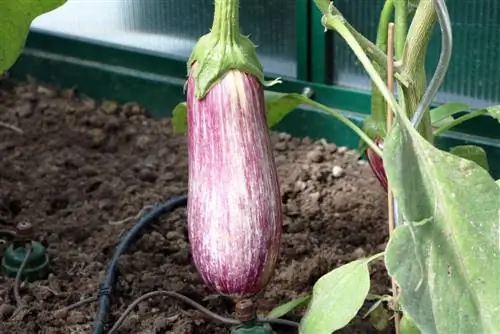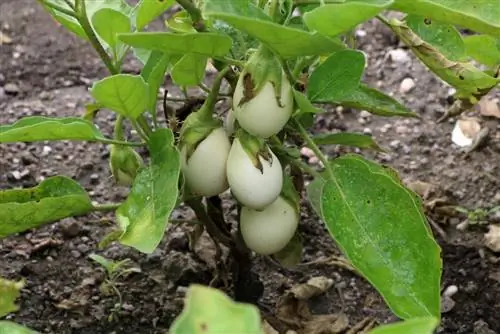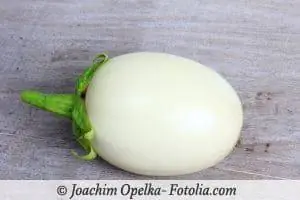- Author admin [email protected].
- Public 2023-12-17 03:39.
- Last modified 2025-01-24 12:45.
Eggplants or eggplants are central ingredients for a lot of delicious Mediterranean dishes. But they also taste very simply prepared, i.e. simply cut into pieces and fried in the pan with a little s alt, pepper and butter. In any case, it's worth trying out growing egg plants, because the productive plant is actually quite easy to care for:
Planting eggplants
You can grow your egg plants from seeds that you sow in March and prick out when they are a few centimeters in size. The small eggplants can then be placed individually in pots with nutrient-rich soil and grown in the greenhouse or in a bright window. The optimal growing temperature for the heat-hungry plants is 25 °C. Towards the end of May, the egg plants and the bales are planted outdoors.
At this time, early young plants are also available that can be planted in the garden. The individual rows should be about 60 cm apart, and the distance between the individual plants should also be at least 50 cm. Since, as mentioned, the egg plants really need warmth, it is best to plant them outdoors in black mulch, as this increases the soil temperature. If the young plants are covered with fleece for the first few weeks, they will grow and develop better.
If you have the opportunity, you can also grow the egg plants under so-called floating windows, i.e. under glass windows that are placed on top. To do this, small eggplant plants are placed in a bed that is warmed under the window and are allowed to grow under this protection. When they get taller, around mid-summer, the windows need to be raised higher, e.g. B. place a flower pot underneath or something else with a suitable height. If you plan to carry out such cultures more often, you can also build a real slatted frame around the bed, from which the heat windows can then be placed.
Egg plants need plenty of water in summer and they are very hungry for nutrients. They want to be fertilized with compost or receive universal fertilizer in the irrigation water every week. You have the choice whether you grow your eggplants on a single shoot, similar to tomatoes, i.e. remove all side shoots, or whether you let them grow like a bush.

However, this only makes a decisive difference if you grow the egg plants in the greenhouse, then you will either have a few large fruits or several, but smaller ones. When grown outdoors, the plant only has the strength to ripen around five fruits. They can also develop on the bush; the remaining fruit sets are simply pinched away. That's why the shrub-like growth is usually chosen outdoors, as it requires less work than growing a shoot.
You can ensure or increase fruit set by gently shaking the plants occasionally at midday when the flowers have appeared. In this way you actively help the egg plant with pollination. However, from the beginning of August you should remove all flowers, as the resulting fruits would no longer ripen in our climate. This shrub should definitely be tied to a stake outdoors to make the plant more stable. In the greenhouse, the eggplants can be tied with strings so that they do not become unbalanced as they continue to grow.
The heat-loving plant usually only produces a really rich harvest when grown in a greenhouse. You definitely have to make sure that every fruit on the plant ripens; the eggplants only have optimal harvest quality in a very short time. This means looking carefully and noticing when the fruit peel is completely colored and shiny. Then you only have a day or two left to harvest; if you let the eggplant fruit hang longer, it will become dull and have a very soft interior. This is not just a visual impression, as the ripeness increases the aroma also suffers.
Overwintering egg plants
Basically, the eggplants are perennial, but hardly anyone bothers to actually overwinter the eggplants. It's similar to tomatoes: They're perennial, sure, but they're always growing at the limit of their vigor in our areas, which are very cold and light-poor. If they survive the winter, which is even more inhospitable for them, they usually become severely rotten when they shoot in spring and then hardly produce any more fruit the following year.
That's why we usually grow eggplants as annuals, as do tomatoes and peppers. However, you can take seeds from this year's generation and grow them next year. To do this, you would have to let a fruit become overripe and sort out the seeds from the spongy pulp, which should then be dried and stored in a dry place until spring.
If you would like to overwinter your egg plants, they must be brought indoors in the fall. They are then cut back and placed in a bright, not too cool room or in a heated greenhouse (above 10 °C) to overwinter. However, winter here is really not the right climate for a plant of this origin, so you will probably have to deal with pests that attack the weakened plant. It also takes quite a long time for the egg plants to get going again in spring. If you have sown egg plants at the same time, they can usually keep up with their development.
Special egg plants on the balcony or in the winter garden
But there are special eggplant varieties that produce lots of smaller fruits and are therefore ideal for growing in a bucket. It's definitely worth trying to overwinter these plants; you can put a pot in the house quite quickly. These egg plants also need a bright location with at least 10 °C and can then be used for several years.






